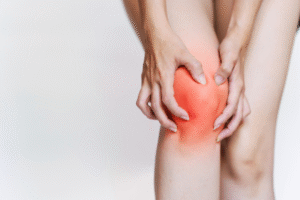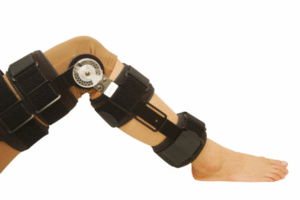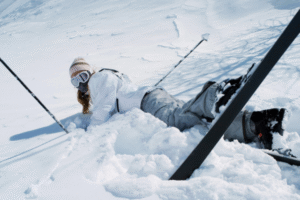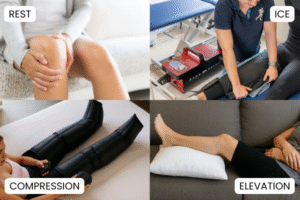If you’ve just injured your knee, you’re probably thinking about pain, swelling, and how long you’ll be off your feet. But there’s something most people don’t realise: the exact angle your knee is held in during the first days or weeks can make a huge difference to your healing.
Get it right, and you protect the damaged tissues and place them in the closest position, allowing them to heal in the best possible way.
Get it wrong, and you risk slowing your recovery or having tissues heal in a stretched position, resulting in a lax joint for life.
In this guide, I’ll explain the best angles for common knee injuries, why they matter, and how to protect your knee in those crucial early stages.


Why the Knee Angle Matters
When you injure ligaments, cartilage, or tendons in your knee, the body immediately begins a healing process.
One key principle is tissue approximation — bringing the torn or damaged ends of tissue closer together so they can reattach and heal strongly.
Think of it like repairing a rope: if the frayed ends are pulled apart, they won’t reconnect properly. But if you bring them together and keep them still, the repair is much stronger.
The position your knee is held in after injury can either support that healing or put it under unnecessary strain.
That’s why early reducing mobilisation — in the right angle — is so important.


Modern Evidence & The Cross Bracing Protocol
In the past, many ligament injuries (especially ACL tears) were assumed to require surgery.
Now, research is showing that some ACL injuries can heal without surgery — if they are positioned and protected correctly in the early weeks.
One approach gaining attention is the Cross Bracing Protocol: keeping the knee in a bent position (around 90°) for a period, then gradually increasing movement, to encourage natural healing.
But the correct position to hold the joint in varies depending on which structure is injured — and sometimes, with multiple injuries, decisions have to be made about which structure takes priority.


Best Angle Restrictions by Injury Type
Anterior Cruciate Ligament (ACL)
• Initial restriction: 30–90 degrees until MRI confirms the diagnosis and the management plan is clear.
• Then: Depending on severity and surgical decision, the knee may be fixed at 90°, restricted 30–90°, or have no restriction at all if the damage is minor or the patient chooses to have reconstructive surgery.
Medial Collateral Ligament (MCL)
• Grades II & III sprains: Restrict movement to 30–90 degrees.
• This reduces strain on the ligament while allowing some safe mobility.
Posterior Cruciate Ligament (PCL)
• Bracing in full extension or using a specific PCL brace is essential.
• This position minimises backward pull on the shin bone and lets the ligament heal in the correct length. The PCL brace is expensive but allows you to bend the knee to 50 degrees.
Posterior Lateral Corner (PLC)
• Full extension is recommended to protect multiple stabilising structures on the outside/back of the knee.
Tibial Plateau Fracture
• Full extension to avoid shifting the fractured bone and to promote optimal alignment.
Quadriceps Tendon Rupture
• Full extension to protect the repair site and prevent the tendon from stretching.
Multi-Ligament Injuries (e.g., ACL + PLC)
• Often, the knee is kept in full extension, prioritising repair of the PLC and other structures.
• Sometimes this means “sacrificing” the ACL initially, with surgery to reconstruct it later.


Real-Life Example
Grace, a 45-year-old skier, twisted her knee in a low-speed fall, when the binding did not release. The pain was sharp, and she fell over. On composing herself, she stood up to try to ski down, but her knee felt so wobbly and unstable that she fell over and was taken down by ski patrol to the on-mountain medical clinic. Her nurse suspected an ACL injury, but as an MRI was not available, she saw a sports physio the next day. Her knee was braced between 30–90 degrees immediately to protect and approximate the ACL while awaiting imaging and preparing to fly home. The MRI confirmed a minimally damaged ACL and partial MCL tear. Because her knee was restricted early, she decided to restrict the knee to 90 degrees for three weeks, from 7-28 days post injury, and both the ACL and MCL healed very well.


Why Your Choice of Practitioner Matters
Not every healthcare professional pays close attention to angle restriction in the acute phase — but it can make or break your recovery.
A sports physiotherapist or sports medicine doctor who understands acute knee protocols will:
• Assess your knee immediately.
• Choose the right angle based on the likely injury.
• Adjust your restriction as your diagnosis and plan become clearer.
Choosing wisely in those first days can protect your long-term outcome.


Action Plan: What To Do If You Injure Your Knee
1. Stop the activity immediately to avoid further damage.
2. Apply RICE: Rest, Ice, Compression, Elevation.
3. Avoid twisting, deep bending, or locking the knee straight until you’ve been assessed.
4. See a sports physiotherapist within 48 hours.
5. Get an MRI promptly to confirm the diagnosis.
6. Follow the angle restriction prescribed — even small changes can stress the injury.
7. Reassess regularly as swelling reduces and your plan becomes clearer.


Final Thoughts
In the first days after a knee injury, every decision counts — and one of the biggest is how your knee is positioned.
Get this right, and you’ll set the stage for better healing, less stiffness, and a faster return to the activities you love.
Seek expert help early, follow the restriction advice closely, and give your knee the best possible chance to heal.
Recommended Knee Restriction Angles After Acute Injury
This table outlines the recommended restriction angles for various acute knee injuries, including important notes for each case. It can be used as a quick reference guide for patients and practitioners.
Injury Type | Recommended Restriction Angle | Notes |
ACL (initial) | 30°–90° | Until MRI; then adjust depending on severity & surgery decision |
MCL (Grade 2 & 3) | 30°–90° | Protects ligament while allowing some safe movement |
PCL | Full extension | Prevents backward pull on shin bone |
Posterior Lateral Corner (PLC) | Full extension | Protects multiple stabilising structures |
Tibial Plateau Fracture | Full extension | Avoids shifting fractured bone |
Quadriceps Tendon Rupture | Full extension | Prevents tendon stretch |
Multi-Ligament incl. PLC | Full extension | Often prioritises PLC repair; ACL surgery later if needed |

